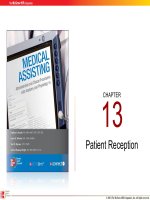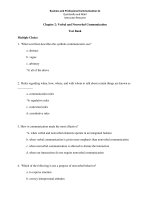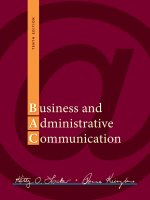Lecture Business and administrative communication: Chapter 13 - Kitty O. Locker, Donna S. Kienzler
Bạn đang xem bản rút gọn của tài liệu. Xem và tải ngay bản đầy đủ của tài liệu tại đây (545.08 KB, 20 trang )
Chapter 13
Writing Job
Application Letters
Copyright © 2015 McGrawHill Education. All rights reserved. No reproduction or distribution without the prior written consent of McGrawHill Education.
Résumés vs. Job Letters
Résumés
Job Letters
Adapted to a position
Adapted to needs of
one organization
Summarizes all your
qualifications
Shows you know
organization, how
your qualifications can
help it, and how you
differ from other
applicants
132
Résumés vs. Job Letters, continued…
Résumés
Job Letters
Avoids controversial
material
Explains complicated
situations (e.g., career
change or gap in
employment)
Uses short, parallel
phrases and
fragments
Uses complete
sentences in wellwritten paragraphs
133
Employer and Job Research
Learn about employers and jobs
Research the organization
Find out who will receive the letter
Learn about the job
Tap into the hidden job market
Conduct information interviews
Conduct referral interviews
134
Job Application Letters: Content
and Organization
Focus on…
Qualifications for major requirements of
job
Points that separate you from other
applicants
Points that show your knowledge of
organization
Qualities that every employer is likely to
value
135
Job Application Letters: Techniques
Do these things in both kinds:
Address letter to a specific person
Name specific position you’re applying for
Be specific about your qualifications
Show how you differ from other applicants
Show knowledge of the organization and
position
Refer to your résumé (enclose it)
Ask for an interview
136
Organize Solicited Letters
1. State
that you’re applying; name the job
Tell how you know about job
Show that you have main qualifications job
requires
Summarize other qualifications
1. Develop
your main qualifications in detail
Be specific about what you’ve done
Relate achievements to work you will do in new
job
137
Organize Solicited Letters,
continued…
3. Develop
other qualifications, even if not
required
Show what separates you from other
applicants
Illustrate knowledge of the organization
3. Ask
for an interview
Tell when available to interview and to begin
work
End on a positive, forward-looking note
138
Organize Prospecting Letters
1.
2.
3.
Catch the reader’s interest
Create bridge between attention-getter and your
qualifications
Develop your strong points in detail
4.
Be specific
Relate what you’ve done in past to what you could do now
Show knowledge of organization
Identify the role you wish to fill
Ask for an interview
Tell when you’re available
End with a positive, forward-looking statement
139
Email Application Letters
Choices
Paste traditional letter into e-mail screen
Edit letter so it fits one
e-mail screen
Include name as part of subject line
Put the job number/title in the first paragraph
Use standard business letter features and end
with your name
Use standard business language Omit ALL CAPS
and emoticons
1310
Create a Professional Image
1311
Professional Image: Writing Style
Use smooth, concise writing style
Use technical jargon of your field
Avoid businessese and stuffy words
Use a lively, energetic style that makes
you seem real
1312
Professional Image: Positive
Emphasis and YouAttitude
Avoid words with negative connotations
Show how your background applies to the employers
Show what you can do for employers, not what they
can do for you
Don’t plead or apologize
Don’t use you when you mean yourself or all people
Use I infrequently; revise to use me or my instead
Avoid starting every paragraph with I
Begin sentences with phrases or clauses
1313
Professional Image: Paragraph
Length and Unity
Make first and last paragraph fairly short
—4 or 5 typed lines maximum
Vary paragraph length
Cover only one subject in long paragraphs
Divide paragraphs that cover two or more
topics
1314
Professional Image: Letter Length
Write at least three paragraphs
Keep to one page
Tighten each sentence
Use slightly smaller margins
Select a font size one-point smaller
Use 2 pages, if needed
Put at least six lines of text on page 2
Use extra space to add details about your
experience
1315
Professional Image: Editing and
Proofreading
Edit and proofread carefully!
Check content one last time
Don’t reveal frustration with job search
Check your tone
Don’t beg or show too much gratitude for
commonplaces such as reading the letter
1316
Professional Image: FollowUp
Don’t be a pest
Contact employer after
two or three weeks, if
you hear nothing
One week is OK to check
if materials have been
received
1317
Application Essays
Chance to expand on your best points in
more detail
Capture audience’s interest and show
you are exceptional
Uses essay format instead of letter
Insert personality into writing
May use anecdotes that
Show you developing as a professional
Outline future goals
1318
Application Essays: Writing Guides
Follow directions closely
Use focal point/unifying theme
Catch audience’s attention in opening
Use vivid and unique details
Avoid unsupported generalities and clichés
Employ topic sentences
Reveal your personal voice
End with strong conclusion
1319
Social Networking and
Personal Websites
Many employers find new employees by
searching on the Internet
Social networking and a personal website
functions as a virtual cover letter
Manage
your social networking profiles
Use key words
Keep your profile pictures professional
Manage your posts in social networks
Create an effective personal website
1320









